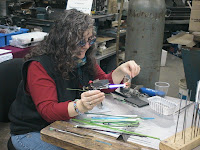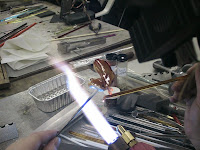
Figures - I have a production order to fill - and I'm out of a required colour. Not only am I out of it, but everyone I know is out of it. :-(
The colour in question is
Moretti 422 - called, imaginatively enough - "
Orange." There is a batch of Moretti 424 floating around that in the rod, before working, looks exactly the same as the 422 - a nice bright orange. But once worked, it goes reddish. In the first pic - you can see the 422 on the left, and two of this lot that looks exactly like 422 before working. When you look at the rod in cross section - at the cut end - the 422 is almost completely uniform - the barest hint of being lighter in the centre. The odd lot has a distinctly lighter core.

So, I then when looking for anything that I thought might make a reasonable substitute.
Here, in the second pic, you can see the wide variety of choices, and the results. (The rod is behind the bead.)
From the bottom, we have a mandrel with known
Mor 422 on the left.

Notice, even it will go dark red if over-heated. Next to it are two beads of
CiM 241 Creamsicle. Reminds me of an HB pencil. Nice colour. Above that, we have
Vetro 943 - Orange Sherbet. In real life, the rods lying with the other rods - all look orange - but in this picture, it looks more like a salmon pink. The finished bead is actually a nice flesh colour, if you are doing sculptural people. Mind you, I remember someone telling me about a glass that was a great colour for her angels, but would strike, with the repeated re-heating that goes with sculptural work, to a bright orange, making for a distinctly odd-looking angel - I wonder if this is it?

Next we have
Vetro 944 - Tangerine Sparkle. It looks distinctly "sparkly" (shimmery inside) when you are working it - and for a change - this bead retains some of that once cool. It is semi-translucent. I bet this would make a nice "wave" bead - I guess it would be a flame bead at that point. Above that is
Vetro 939 - Intense Tangerine. Slightly darker, a little redder, and more streaky transparent and opaque.

Then we have
Vetro 805 - Orange Dreamsicle. (pic on right, bottom) When you look down this rod, the core is white, with an orange coating - just like those Orange Creamsicle/Dreamsicles we got as kids. Which probably taste better in memory than they did in real life. I was never a popsicle fan - Fudgesicles or Creamsicles - you could keep your Popsicles for my money. Anyway - this comes out really streaky. It's really pretty cool - but some rods are really, really shocky. The first one turned itself into frit, and the second rod worked ok. I'd be tempted to run all of them through the kiln for an annealing cycle - just cut down on the shocking.
And above that, decorated with silvered ivory, is the suspected 424 . I have all kinds of unlabeled orange that looks like it might be right. But isn't. Apparently.

And here they all are again, labeled, in case you are totally confused by now. The hand is for colour comparison.
Mid-tone non-red orange. As elusive as a beast as a "pretty pink" is. Was.
 Two days of demo'ing torches and talking about glass, torches, beads, tools and the joy of working with glass to any poor unsuspecting soul who wanders in off the street, enticed by the "free chili" sign.
Two days of demo'ing torches and talking about glass, torches, beads, tools and the joy of working with glass to any poor unsuspecting soul who wanders in off the street, enticed by the "free chili" sign. That's Amy in the first photo - on a Nortel Minor - working on a frog bead.
That's Amy in the first photo - on a Nortel Minor - working on a frog bead. Oh, and here's a very nicely lined bead - courtesy of Peter's new bead lining machine - which is just about ready for release. More on that later. But I can say - this machine has some significant usability improvements!
Oh, and here's a very nicely lined bead - courtesy of Peter's new bead lining machine - which is just about ready for release. More on that later. But I can say - this machine has some significant usability improvements! 














































